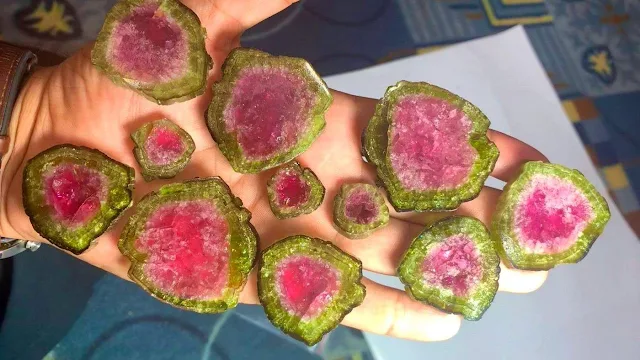What is Watermelon Tourmaline (Photos)
Watermelon Tourmaline is a unique variety of tourmaline known for its distinctive pink or red core and green outer layer, resembling a slice of watermelon. This rare and valuable gemstone is highly sought after for jewelry due to its vibrant colors and durability. With a Mohs hardness of 7 to 7.5, Watermelon Tourmaline is relatively resistant to scratches and has stable properties, making it resilient against heat and chemicals.
A notable feature of all colored Tourmaline gems, including Watermelon Tourmaline, is pleochroism—the phenomenon where the color shifts when viewed from different angles. In some tourmaline stones, this effect is subtle, while in others it is quite pronounced, requiring gemstone cutters to carefully orient the stone to enhance its color.
Watermelon Tourmaline is found in select locations worldwide, with the primary source being Minas Gerais, Brazil. Other notable deposits are in Nigeria, Madagascar, Afghanistan, Sri Lanka, Australia, and parts of the United States.
 |
| Watermelon Tourmaline: What Is Watermelon Tourmaline. A slice of watermelon tourmaline |
What Does Watermelon Tourmaline Look Like
As its name suggests, watermelon tourmaline exhibits banded colors that resemble a ripe slice of watermelon. The gem features a red or pink center surrounded by a rim of green, often separated by a sliver of pale pink or white. While the brightly colored zones can also appear at either end of the gem, there is some debate as to whether these stones should be classified as watermelon or simply bi-color tourmalines.
Watermelon tourmalines with vivid, clearly separated colors are very rare and thus command high prices. According to gemologist Matthew Morrell, 'Clean stones with good crystal in the 4-7 carat range, with an even distribution of each color, change hands in Europe for between $500-$600 per carat.'
Cutting the stone into slices, like a loaf of bread, rather than faceting the rough, accentuates the watermelon-like banding, making the resemblance to a real watermelon even more striking. Their complex structure makes tourmalines very challenging to cut; a great deal of expertise is required to identify areas of tension within the stone, which could otherwise lead to cracking during the cutting process.
 |
| Watermelon Tourmaline earrings. |
What Causes Watermelon Tourmaline Colors
The bi-coloured and multi-coloured zoning that we so often see in tourmaline gems happens when the trace elements change in concentration or composition during a crystal’s growth. These unique gems can have coloured zones across the length of the crystal, or they can have a core of one colour and an outer edge of another colour. A single tourmaline crystal can contain up to 15 different colours or shades – no wonder it has been nicknamed the “Rainbow Gem”.
In watermelon tourmaline, pink and green Elbaite crystals are found in the same stone, and these colour zones provide a visual record of its formation process.
As the watermelon tourmaline crystal grows and thickens, it is exposed to different minerals such as manganese and lithium, which cause the gem to change colour from a pink centre through a pale zone to the green rind.
 |
| A slice of watermelon tourmaline |
Watermelon Tourmaline Properties
Color: Watermelon Tourmaline displays a unique combination of colors, typically featuring a pink or red center and a green outer layer, resembling the appearance of a watermelon. This color zoning is a result of the crystal's formation process where different elements are incorporated into the crystal lattice at different stages.
Transparency: Tourmalines, including Watermelon Tourmaline, are generally transparent to translucent. The transparency can vary depending on the quality of the crystal, with higher quality specimens being more transparent.
Luster: Watermelon Tourmaline exhibits a vitreous luster, meaning it has a shiny, glass-like appearance.
Hardness: On the Mohs scale of mineral hardness, Watermelon Tourmaline has a hardness of 7 to 7.5, making it relatively hard and durable. This hardness allows it to be used in various types of jewelry without being easily scratched.
Crystal Form: Hexagonal prisms and striated columns, often elongated and tapering to a point.
Cleavage: Watermelon Tourmaline does not exhibit perfect cleavage, meaning it does not break along specific planes. Instead, it tends to break irregularly when subjected to force.
Fracture: The fracture of Watermelon Tourmaline is conchoidal, meaning it breaks with a smooth, curved surface, similar to the inside of a shell.
Fluorescence: Some Watermelon Tourmalines may exhibit weak fluorescence under ultraviolet light, with the pink/red and green areas sometimes showing different intensities of fluorescence.
Pleochroism: Watermelon Tourmaline often exhibits strong pleochroism, which means it shows different colors when viewed from different directions. This is due to the crystal's anisotropic nature and the varying absorption of light by the different crystal axes.
Refractive Index: The refractive index of Watermelon Tourmaline is approximately 1.62 to 1.64, which contributes to the gemstone's brilliance and dispersion of light.
These properties make Watermelon Tourmaline a popular choice for jewelry and decorative objects, prized for its unique color combination and durability.
 |
| Watermelon tourmaline slices |
Watermelon Tourmaline Uses:
Jewelry: Watermelon tourmaline is highly prized in the jewelry industry for its attractive coloration and rarity. It is often cut into faceted gemstones and used in rings, earrings, necklaces, and bracelets. Jewelry designers appreciate its vibrant hues and natural beauty.
Decorative Objects: Watermelon tourmaline slices or polished pieces are sometimes used as decorative objects in home decor.
Gifts: Watermelon tourmaline jewelry or specimens make thoughtful and meaningful gifts for gemstone enthusiasts, collectors, or loved ones.
Chakra Healing: In some alternative healing practices, watermelon tourmaline is associated with the heart chakra and is believed to promote emotional balance, self-love, and healing of past emotional wounds.
Watermelon Tourmaline Photos
 |
| Watermelon Tourmaline slices |
 |
| Watermelon Tourmaline |
 |
| Watermelon tourmaline pendants |
 |
| Watermelon Tourmaline |
See also:
Tourmaline: Species and Color Varieties
Where Does Watermelon Tourmaline Come From
Rubellite - Properties, Value, Occurrence and Uses





